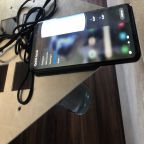Pathfinder Solar Array Spring 2019
Stress Test
Author: Henry Martinez
Table of Contents
Introduction
The fabricated panels have a thickness of 2mm. In order to ensure that the panels can hold the weight of all the components, the project manager and I conducted a live stress test of the panels. The test simulates the amount of stress placed on the panels due to 3 modules.
Analysis
Generation 3’s mechanical design uses panels held in a static position. To ensure that the panels are sturdy enough to hold the amount of weight of the solar cells, custom pcbs, pcb enclosures, and the cabling a stress test was conducted. The total amount of weight of 3 modules, according to the mass report is 364 grams. The weight of 3 modules was chosen because the requirements states that there will be 3 modules placed on top of the Main and Tail panels. All the materials were not yet fabricated so water weight was used as a replacement. The panel was placed onto a table and clamped at 180° to simulate a static position within a channel. The weight was placed at the far end of the panel in order to simulate the max amount of displacement. This process was done 5 times for up to 5 times the weight that would normally be placed onto the panels.
A surface level app was used as a level to determine the offset angle taken from the static position.
| Total Weight (g) | Main Panel
Offset Angle ( ° ) |
Tail Panel
Offset Angle ( ° ) |
| 0 g | 2.9° | .5° |
| 364.23 g | 3.6° | 1.0° |
| 564 g | 3.9° | 1.7° |
| 764 g | 4.1° | 2.1° |
| 964 g | 4.4° | 2.5° |
| 1164 g | 4.6° | 3.2° |
|---|
Conclusion
Overall, the stress test illuminates that despite the small thickness, the panels will be able to hold up to 5 times the intended weight with little displacement. Adding 5 times the weight led to a max displacement of 2.7° meaning the panels are strong enough to hold a position near 180° without much offset.


